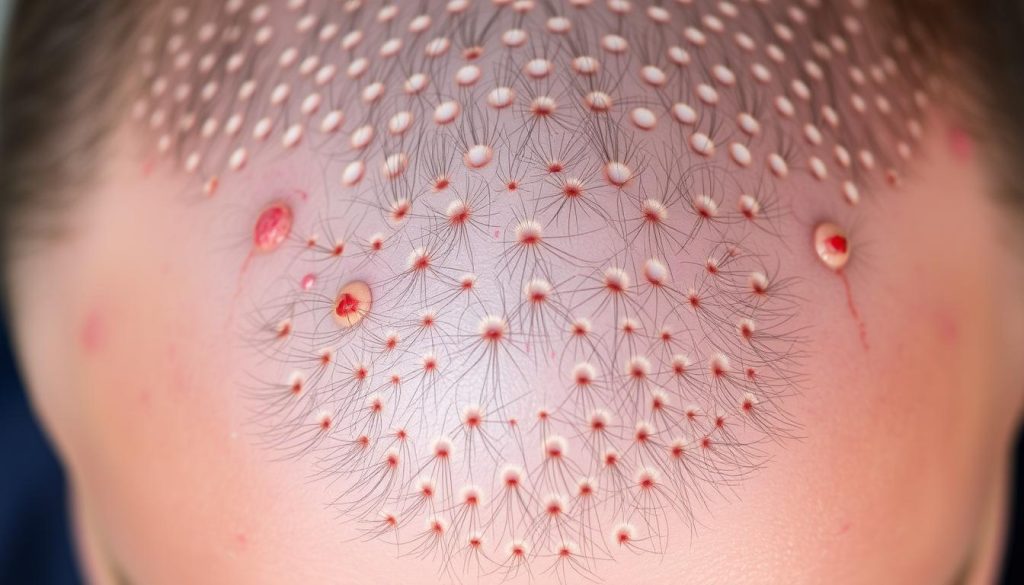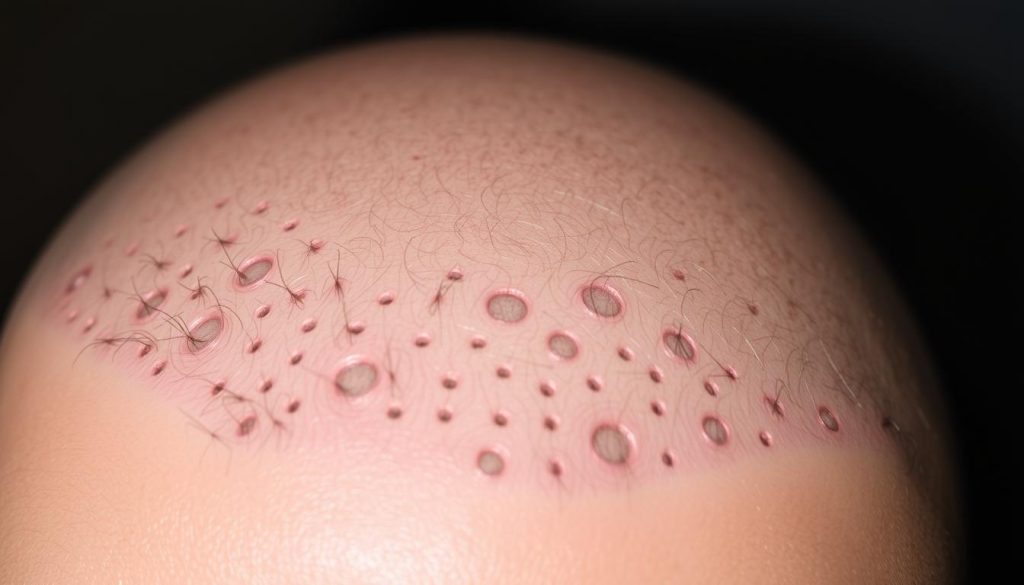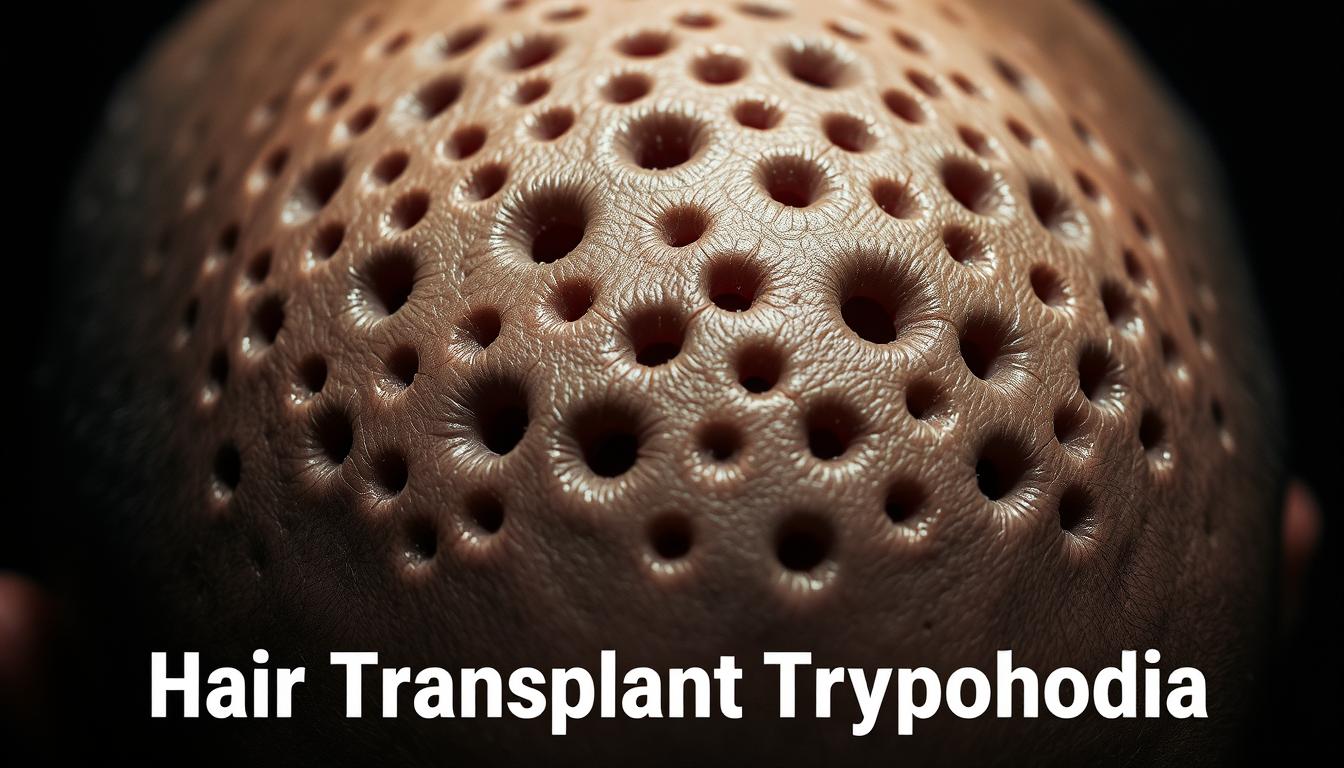For individuals considering hair restoration procedures, a specific anxiety can be a significant concern. Trypophobia, or the fear of small holes, can manifest in discomfort or fear when encountering or anticipating the small holes created during follicular unit extraction (FUE) procedures.
Approximately 1 in 6 adults suffer from trypophobia, and for those seeking hair restoration, this phobia can influence their decision-making process. Understanding this condition is crucial for both patients and medical professionals in the hair restoration field.
Key Takeaways
- Trypophobia is a relatively common phobia that can affect individuals considering hair restoration procedures.
- The fear of small holes created during FUE procedures can cause significant anxiety.
- Understanding trypophobia is essential for medical professionals to provide effective care.
- Practical approaches can help manage this specific phobia while achieving desired hair restoration results.
- Addressing trypophobia can improve the overall experience for individuals seeking hair restoration.
Understanding Hair Transplant Trypophobia
Understanding trypophobia is crucial for both patients and surgeons to ensure a smooth hair transplant process. Trypophobia, a condition characterized by an intense aversion to patterns of small holes or clusters, can significantly impact an individual’s experience during hair restoration surgery.
What Is Trypophobia?
Trypophobia is a relatively unknown phobia that triggers feelings of discomfort, anxiety, or fear in response to specific visual patterns. Common symptoms include nausea, dizziness, and heart palpitations. The exact cause of trypophobia remains unclear, but theories suggest it may be an evolutionary reflex associating hole patterns with potential dangers.
Some common triggers for trypophobic reactions include natural patterns like lotus pods and honeycomb, as well as man-made patterns that can elicit similar responses. The neurological basis of trypophobia is complex and involves the brain’s processing of specific visual stimuli.
How It Relates to Hair Transplantation
The hair transplant process, particularly the FUE technique, creates small, clustered holes in both donor and recipient areas, which can be particularly problematic for trypophobic individuals. Understanding this condition is essential for both patients and surgeons to ensure appropriate preparation and management throughout the hair restoration process.
A comparison of trypophobia triggers in hair transplantation is shown in the table below:
| Trigger | FUE Technique | Trypophobia Response |
|---|---|---|
| Small holes | Creates small, clustered holes | Fear, anxiety, discomfort |
| Clusters | Extraction and implantation sites | Nausea, dizziness, heart palpitations |
As
“The fear of small holes or clusters can be a significant concern for individuals undergoing hair transplant procedures.”
It is essential to address trypophobia concerns to ensure a successful hair transplant experience.
Common Triggers of Hair Transplant Trypophobia
Individuals with trypophobia may experience anxiety during FUE hair transplant procedures due to various visual and psychological triggers. Understanding these triggers is crucial for managing trypophobia during hair transplant procedures.
Visual Triggers During FUE Procedures
The FUE hair transplant process involves several visual elements that can trigger trypophobic reactions. During the procedure, surgeons use a micro punch device to extract follicles, creating small holes in the donor area, typically at the back of the head. These holes are usually less than 1mm wide, as more than half of the surgeons use a punch 0.81-0.9mm in diameter. The recipient area also appears with multiple small incisions arranged in patterns immediately after implantation, which can be particularly triggering for individuals with trypophobia.

Psychological Factors That Intensify the Fear
Underlying psychological factors can intensify trypophobic responses during hair transplant procedures. Anticipatory anxiety and catastrophizing about the procedure’s appearance can exacerbate the fear. Previous negative experiences with medical procedures or exposure to images of holes and patterns can also amplify trypophobia. Moreover, media exposure to hair transplant images without proper preparation can create or worsen trypophobic reactions in susceptible individuals.
Recognizing Trypophobia Symptoms Before Your Procedure
Recognizing trypophobia symptoms before undergoing a hair transplant procedure can make a significant difference in the overall experience. Individuals considering hair restoration should be aware of their reactions to certain visual stimuli that may trigger trypophobia.
Physical Symptoms to Watch For
Trypophobia can manifest through various physical symptoms when an individual is exposed to triggering patterns, such as those encountered during a hair transplant procedure. Common physical reactions include:
- Skin reactions: goosebumps, itching, or other dermatological responses
- Cardiovascular responses: increased heart rate, changes in blood pressure
- Gastrointestinal distress: nausea, dizziness, or other stomach-related issues
Being aware of these physical symptoms can help individuals identify if they are trypophobic.
Emotional Responses That Indicate Trypophobia
Emotional and psychological responses are also significant indicators of trypophobia. These can range from mild discomfort to severe panic attacks when viewing triggering images or patterns. Common emotional responses include:
- Feelings of unease or anxiety: a general sense of discomfort
- Panic or anxiety attacks: intense fear or panic in response to specific visual stimuli
Recognizing these symptoms early can help patients and medical professionals develop appropriate management strategies before the hair transplant procedure, ensuring a more comfortable experience.
The Reality of Hair Transplant Holes
For individuals concerned about trypophobia, understanding what FUE incisions look like can be reassuring. Modern follicular unit extraction (FUE) techniques have evolved to minimize the visual impact of hair transplant holes.
Appearance of FUE Incisions
FUE incisions are typically small, ranging from 0.8 to 1mm in diameter. To put this into perspective, they are roughly the size of a pinhead. The extraction sites are usually distributed across the donor area in a strategic pattern to minimize the appearance of clustering, which can trigger trypophobia. The use of tiny micro punches creates minimal holes that heal quickly, reducing the visibility of the transplant holes.
- FUE incisions are approximately 0.8-1mm in diameter.
- Strategic distribution of extraction sites minimizes clustering.
- Modern techniques use tiny micro punches for minimal holes.
Minimizing Visual Impact with Modern Techniques
Modern FUE techniques have significantly reduced the visual impact of hair transplant holes. The recipient area incisions are even smaller than donor extractions and are designed to blend with existing hair patterns. Specialized instruments and techniques have been developed to minimize the visual impact of both extraction and implantation sites. As a result, the area typically looks like it has been grazed, with slight red scabbing as the wounds heal.

Effective Treatments for Trypophobia
The anxiety and fear associated with trypophobia can be managed with appropriate therapy and techniques. Individuals experiencing trypophobia related to hair transplants can benefit from evidence-based treatments that address their specific concerns.
Cognitive Behavioral Therapy Approaches
Cognitive Behavioral Therapy (CBT) is a highly effective treatment for trypophobia. This therapy helps patients identify and challenge irrational thoughts related to hole patterns, developing healthier responses to triggers. By addressing the cognitive aspects of the phobia, CBT enables individuals to manage their anxiety and fear more effectively.
Exposure Therapy and Desensitization Techniques
Exposure therapy is another approach used to treat trypophobia. This involves gradual exposure to the feared stimuli, starting with less triggering images and progressing to more challenging visual stimuli. Systematic desensitization helps individuals become comfortable with the visual aspects of hair transplant procedures, reducing their anxiety and fear over time.
By combining these therapies with relaxation techniques and, in some cases, medication, individuals with trypophobia can undergo hair transplant procedures with significantly reduced distress.
Managing Trypophobia During Hair Transplant Procedures
Open communication with the hair surgeon is key to managing trypophobia during hair transplant procedures. Patients who are open about their fears and anxieties can receive tailored support and accommodations to make the experience less distressing.
Pre-Procedure Preparation Strategies
Effective preparation is crucial for minimizing trypophobia-related anxiety during hair transplant procedures. Strategies include gradual exposure to medical images and virtual consultations to build comfort with the process. Patients can also benefit from detailed information about the procedure, including what to expect during and after the surgery.
- Gradual exposure to medical images
- Virtual consultations
- Detailed information about the procedure
Communication Tips for Your Surgical Team
Clear communication with the surgical team is vital for managing trypophobia during the hair transplant procedure. Patients should be encouraged to express their fears and anxieties openly. The surgical team can then provide personalized support and accommodations, such as sedation options or visual management techniques, to minimize distress.
| Communication Strategy | Description |
|---|---|
| Openly discuss trypophobia concerns | Inform the surgical team about your trypophobia to receive tailored support. |
| Use specific language to describe anxiety levels | Clearly communicate your anxiety levels to help the team provide appropriate accommodations. |
Post-Transplant Recovery for Trypophobic Patients
Trypophobic patients require special consideration during the hair transplant recovery process to minimize anxiety triggers. The healing process after a hair transplant involves several stages, and being prepared can significantly reduce discomfort.
Minimizing Visual Exposure to Healing Grafts
To minimize visual exposure to healing grafts, patients can adopt specific hair styling approaches and wear hats during the initial recovery period. It’s also advisable to limit mirror use to avoid triggering trypophobia. By styling their hair appropriately, patients can cover the transplant area, reducing the likelihood of encountering triggering patterns.
Speeding Up the Recovery Process
Optimizing the recovery process involves following the surgeon’s advice, using proper recovery products like shampoos and lotions, and ensuring the procedure is done by a trusted surgeon using up-to-date techniques. The use of the smallest micro punch tool possible can also contribute to a quicker recovery.
| Recovery Stage | Visual Changes | Care Instructions |
|---|---|---|
| 0-3 days | Redness, swelling | Gentle washing, medicated shampoos |
| 4-7 days | Scabbing, crusting | Continue gentle care, avoid scratching |
| 1-2 weeks | Gradual healing | Resume normal hair care, gentle styling |
By understanding the healing process and following post-operative care instructions precisely, trypophobic patients can minimize their exposure to potentially triggering visual stimuli during the hair transplant recovery period.
Advanced Hair Transplant Techniques for Trypophobia Sufferers
The field of hair transplantation has seen significant innovations aimed at reducing the visual triggers associated with trypophobia. These advancements ensure a less invasive and visually triggering process, making hair transplants a more viable option for individuals sensitive to small, clustered holes.
Specialized FUE Methods That Reduce Triggering Patterns
One of the most effective techniques to minimize the impact of FUE hair transplant trypophobia is the modern approach to Follicular Unit Extraction (FUE). Specialized FUE methods, such as sapphire FUE, create smaller, less noticeable incisions that may be less triggering for trypophobic patients. Custom extraction patterns can be designed to avoid the uniform grid-like appearance that often triggers trypophobia.
Alternative Approaches to Consider
For severe trypophobia sufferers, alternative hair restoration approaches may be suitable, including non-surgical options and modified surgical techniques. Direct Hair Implantation (DHI) techniques differ visually from traditional FUE and might be advantageous for trypophobic patients. Partial or staged procedures can be planned to minimize the visual impact at any one time while still achieving comprehensive hair restoration results.
Technological innovations in the field continue to improve the experience for patients with specific phobias and sensitivities, making hair transplant procedures more accessible and less intimidating.
Finding the Right Hair Transplant Specialist for Trypophobia Concerns
For individuals with trypophobia, finding the right hair transplant specialist can make all the difference in their experience. It’s crucial to select a professional who not only has experience with hair transplant procedures but also understands and can address trypophobia concerns.
When searching for a surgeon, it’s essential to ask the right questions during consultations. This includes inquiring about their approach to managing trypophobia during the procedure and recovery. Patients should also review before-and-after photos to understand how the transplant sites will appear.
Assessing a clinic’s sensitivity to psychological concerns and their willingness to accommodate special requests is vital. Integrated care approaches that include psychological support can significantly enhance the overall experience. By carefully evaluating these factors and interpreting reviews from other patients with similar concerns, individuals can make an informed decision.
Ultimately, finding a hair transplant specialist who understands and addresses trypophobia concerns is key to a successful and stress-free hair transplant experience. By doing thorough research and asking the right questions, patients can ensure they receive the best possible care.
FAQ
What is the likelihood of experiencing trypophobia during a Follicular Unit Extraction (FUE) procedure?
The likelihood varies from person to person, but understanding the procedure and its visual triggers can help prepare individuals with trypophobia.
How can I manage my anxiety related to the appearance of FUE incisions?
Cognitive Behavioral Therapy (CBT) and exposure therapy are effective approaches to managing anxiety related to the appearance of FUE incisions.
Are there any specialized FUE methods that can reduce triggering patterns for individuals with trypophobia?
Yes, some surgeons use specialized FUE methods that minimize the visual impact of the procedure, making it more comfortable for individuals with trypophobia.
What are the most common visual triggers during FUE procedures that may cause discomfort for individuals with trypophobia?
Clusters of small holes or incisions in the donor area can be a common visual trigger, but modern techniques have minimized this impact.
How can I communicate my trypophobia concerns to my surgical team before the procedure?
It’s essential to discuss your concerns with your surgeon and their team before the procedure to understand their approach to minimizing visual triggers and to develop a plan for managing your anxiety.
What are some strategies for minimizing visual exposure to healing grafts during the recovery process?
Keeping the recipient area covered and following post-operative instructions can help minimize visual exposure to healing grafts.
Can trypophobia symptoms be a contraindication for undergoing a FUE procedure?
While trypophobia symptoms should be discussed with your surgeon, they are not typically a contraindication for undergoing a FUE procedure.
How can I find a qualified surgeon who understands and can accommodate my trypophobia concerns?
Researching and consulting with surgeons who have experience with patients with trypophobia can help you find a qualified professional who can accommodate your needs.
